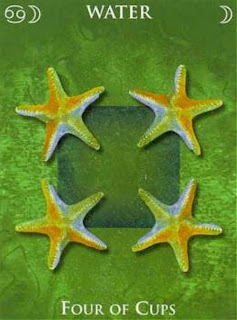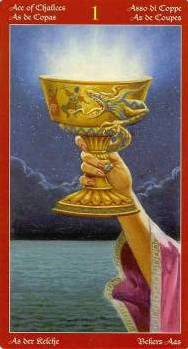Astrological associations for the Minor Arcana cards typically involve both a planet and a zodiac sign. The attributions established by the Order of the Golden Dawn (OGD) are by far the most commonly used. However, some Tarot decks use a different set of associations. As a professional astrologer, I find it interesting to compare and contrast these associations from deck to deck. The use of astrological associations with Tarot is completely up to the reader. This is merely intended to be interesting and fun.
Credits for the decks and books mentioned in this post can be found
HERE.
I recently became acquainted (through
The Tarot Guild) with Anna Burroughs Cook and her
Tarot Dynamics (TD) system for reading the cards. The system is closely tied into astrology, and I find it fascinating. Starting with this entry, I plan to include the TD interpretation for each card in my Astrological Associations Series on this blog. I will be using the Universal Waite Tarot to illustrate my notes about the TD system. My comments provide only a glimpse into the TD system. If you are interested in studying the system further, I recommend visiting the
TD web site, reading the
marvelous interview Anna did with Bonnie Cehovet, or purchasing the book
Tarot Dynamics--Learn to Read Any Spread (Kima Global Publishers, 2009).
Today's blog entry is about astrological associations for the
FOUR OF CUPS.
Tarot Dynamics System (Anna Burroughs Cook)
Quick Summary of Astrological Associations for the Four of Cups: Fourth House (Home, Family, Nurture, The Past), Cancer, the Moon
In Anna Cook's TD system, cards 2 through 10 are known as Subject Cards. They are viewed as having a strong impact on our immediate agenda, on situations, moods, opportunities or obstacles that pass quickly. The number on the card reveals the situation. The suit and definition suggest the reason for the situation, along with options and the most beneficial approach to take.
The suit of Cups represents Emotion, including dreams and that which gives meaning to your life. This is a fairly standard Tarot association. The astrological aspect of this system comes into play when we start talking about the number on the card.
To interpret the number Four, we look at the astrological Fourth House, which is considered to be the house of home, family, nurture, and the past. In a birth chart, this house helps us understand how we feel "at home" and secure, where we have a sense of "belonging." Our past has a huge effect on where and how we feel secure or "at home" and what we are sentimental about.
In astrology, the Fourth House is associated with the zodiac sign Cancer, which is ruled by the Moon (representing our emotions).
Based on the astrological associations described above, it's easy to see that the Four of Cups is going to have a very strong emotional component that relates to our sense of security and belonging. I would say that we are likely being asked to explore something to do with our daily life or home life (perhaps with an emphasis on how a past experience or experiences might affect our current approach to a situation). Anna's key words for the Four of Cups are "Emotional / Incentive, Security." On the positive side, there may be feelings of self-satisfaction. On the negative side, there may be feelings of anxiety.
Thoth Tarot by Aleister Crowley
For Crowley and the Order of the Golden Dawn (OGD), the Four of Cups represents the energy of the Moon (emotions) in Cancer (a Water sign ruled by the Moon and known for being imaginative, emotional, sensitive, loyal, and moody). Crowley titles the card "Luxury." (Book T, on the other hand, titles it "Blended Pleasure.") Hajo Banzhaf and Brigitte Theler (in Keywords for the Crowley Tarot) describe the energy of the card as: "caring, motherly, devoted (Cancer) feelings (Moon)." Osiris Snuffin points out that all of this card's main attributions are association with Water, which can be seen as weakness or an "abandonment to desire" (the exact words used by Crowley in discussing this card).
One World Tarot by Crystal Love
Crystal Love associates the Four of Cups with the third subdivision of the sign Cancer, with the Moon as both the natural ruler and the subruler. She describes this energy as follows: "...a compassionate nature, love of home, family, and romance...rapidly shifting moods and emotions and an overly sensitive nature." Love writes that the Four of Cups can suggest "too much of a good thing" or "happiness that has reached a peak and can proceed no further," which can lead to "boredom, stagnation, dissatisfaction."
A.E. Thierens, PhD. (Astrology and the Tarot)
Thierens describes the Four of Cups as follows: "The Water of the soul on the Twelfth house, which rules many changes, and adverse influences." In astrology, the Twelfth house is associated with the zodiac sign Pisces, ruled by Jupiter (in traditional astrology) and/or Neptune (in modern astrology). It is described by
Astrology Zine as the house of "Spirit, Surrender, Sacrifice and Secrets." The Twelfth House is associated with "bodies of water, chemicals, drugs and drug dependencies, perfumes, dancing, ecstasy, spirituality, self-sacrifice, martyrdom, persuasion through imagination, illusions, deceptions, self-delusions, escapism." An astrologer friend of mine has determined that the Twelfth House represents "limits, delays, and denials." Joanna Martine Woolfolk tags the Twelfth House as the house of "Secrets, Sorrows, and Self-Undoing."
Thierens writes that the Four of Cups can indicate "Discontent with environment, certainly, but at the same time it shows the querent throwing his future on the waters of new adventure, leaving home to wander forth towards new experiences, enlarging the horizon of his views."
(Note: The astrological system devised by Thierens is radically different from that of the OGD. I will not go into detail here, but will simply provide the astrological associations for the card under discussion. If you are interested in learning more about this system, I recommend Thierens' book, Astrology and the Tarot.)
The Mandala Astrological Tarot by A.T. Mann
Like the OGD, Mann's deck associates the suit of Cups with the element Water. Mann describes Cup Two, Three, and Four as "The Rains of Cancer" and associates them with The Summer Solstice (21 June to 22 July). Cup Four is assigned to the Third Decan of Cancer -- Neptune in Cancer (interesting, given the association by Thierens with the Twelfth House/Pisces/Neptune)!
On the King Scale of Color, the color linked with Neptune is pale green. The color for the sign Cancer is yellow-orange. Mann's keywords for Neptune are "divinity, idealism, spirituality, dreamlife, clairvoyance, sensitivity." For the sign Cancer, his keywords are "mothering, fecundation, fertilization, feeling, emotions, mother, home and family, the unconscious, protective, urge, and possessiveness." Mann's divination meanings for Cup Four include "A deeply sensitive and feeling nature is easily susceptible to instability and can be misled. . . A clouded reality can hurt by taking in more than can be understood."
The Whispering Tarot by Liz Hazel
Liz Hazel's suit of Cups is the suit of the Water element, embodying "emotions, feelings, relationships, love, as well as the nature and consequences of emotional attachments." The Four of Cups represents the Moon/Cancer energy we see in other decks. Hazel's illustration depicts a pensive woman lying along the edge of a mystic well. She stirs the water with her finger, scrying for visions. Four cups are placed along the wall behind her, and we can see that this wall opens as a portal to the night sky. I really like the feeling of "moodiness" in this picture.
Hazel notes that this card can suggest "meditation, reflection. . . recuperation from a lost love or an illness. . . a welcome respite from high-paced activity or a vacation -- or a period of sorrows and confusion over contradictory situations." The card can indicate being "bored with a relationship of marriage" as well as "sadness, sorrow at a loss or death, demanding that of the tarot, or any oracle, that which it cannot give. Discovering that dreams were false, or that hopes are unfulfilled. Lost in fantasies."
My Thoughts
From an astrological standpoint, the Four of Cups carries strong influence from the Moon. I don't have any trouble also sensing the energy of the planet Neptune (planet of mystery and illusion). With the zodiac Cancer involved, we are looking at major emotional involvement that can easily distort or disguise reality, causing us to lose perspective and clarity of vision. Insecurities and uncertainties may be unfounded. We have a sense that we are missing something important, that our perception of a situation needs to be reexamined and challenged.
The Moon-Cancer connection of the Four of Cups made me think of a beautiful song written by Joni Mitchell about the daughter she gave up for adoption. The song is called "Little Green" and it begins:
"Born with the moon in Cancer
Choose her a name she will answer to
Call her green and the winters cannot fade her
Call her green for the children who've made her
Little green, be a gypsy dancer."
I welcome your comments!
Zanna Starr






































